Scrapes are an essential element of deer communication, especially during the rutting season. As a hunter who has spent years in the woods, I find it fascinating how deer use these scrapes to signal their presence, assert their dominance, and attract potential mates. So, how often do bucks check their scrapes?
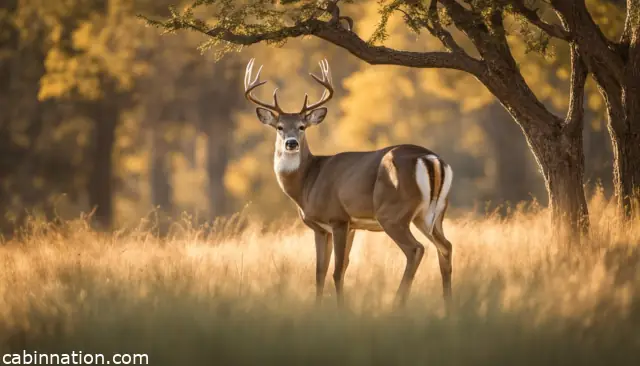
Contents
- How Frequently Do Bucks Visit Their Scrapes
- Types of Deer Scrapes
- Bucks and Their Behavior
- Scrapes in Relation to Rut and Breeding
- Use Mock Scrapes to Attract Bucks
- Use of Scent and Antlers in Scrapes
- Scrape Lines and Scrape Activity
- Final Thoughts How Often Do Bucks Check Their Scrapes
- Frequently Asked Questions
- Related Articles:
How Frequently Do Bucks Visit Their Scrapes
During the pre-rut and two weeks leading up to peak breeding, mature bucks may check a scrape along their trail around 6-12 times every hour.
However, the frequency may change depending on external factors like hunting pressure or weather conditions.
Types of Deer Scrapes
There are a few types of scrapes that I’ve observed in the wild: social scrapes, boundary scrapes, primary scrapes, and secondary scrapes. Each of these has a different role in deer communication, but all revolve around the same concept of a buck scraping the ground with its hooves and depositing scent from one of its seven glands.
Deer will often use their hooves to clear away leaves and debris, creating a small, bare patch of earth to make scrapes. While scraping, they will mix scent from their inter-digital, tarsal, and metatarsal glands with the soil.
Here, they will urinate, mixing their scent with the soil.
This leaves behind a distinct glandular scent that other deer can detect, indicating the buck’s dominance and potential for mate-finding with dominant does.
1. Social Scrapes
Social scrapes are common and serve as a communal message board for deer in the area. Deer of all ages and sexes will visit these scrapes, marking their presence and picking up information about other deer in the area. It is a way for them to exchange information and communicate with each other.
2. Boundary Scrapes
Boundary scrapes, on the other hand, are used by bucks to define and mark the edges of their territories. These scrapes act as a warning to other bucks, signaling that this territory is already claimed. When I come across a boundary scrape, it’s a good indicator that a dominant buck is in the area.
3. Primary Scrapes
Primary scrapes are usually found closer to the core of a buck’s territory and are monitored more frequently by the buck compared to secondary scrapes. They are often located near high-traffic areas, such as food sources or bedding sites. When I encounter a primary scrape, it’s typically a sign that a buck spends a significant amount of time in that area and might be even more likely to return.
4. Secondary Scrapes
Secondary scrapes are less actively maintained by the buck and are often found around the periphery of its territory. These scrapes are still important for the buck to mark and monitor, but they might not receive as much attention as primary scrapes.
When I’m in the field, encountering a secondary scrape still provides useful information about deer movement patterns and the buck’s overall presence in the area. Recognizing each of these scrapes in the field helps me locate potential hunting spots.
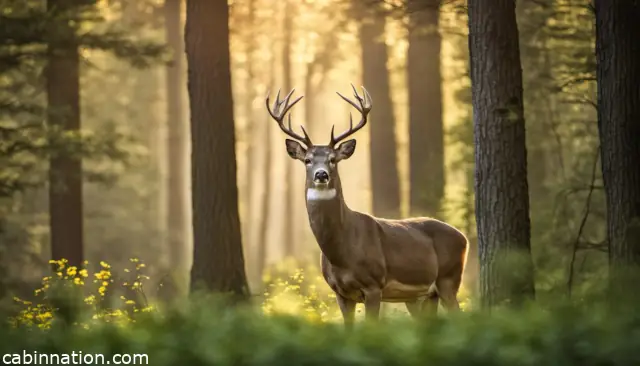
Bucks and Their Behavior
Mature bucks exhibit specific behaviors as they establish dominance and prepare for the rutting season.
Pre Rut
During the pre-rut period, bucks often mark their territory to assert their dominance and to communicate with other whitetails. One primary way bucks do this is by creating scrapes.
These scrapes or markings on the ground and surrounding branches serve as visual and olfactory (smell) signals to other deer in the area.
As a buck scrapes the ground with its hooves, it also rubs its antlers on an overhanging branch, leaving behind scent from glands located on its forehead. This scent, along with the visual display, sends a clear message to other bucks and does in the region.
In general, bucks tend to check their scrapes at regular intervals to maintain their presence and monitor the activity of other deer in the area. This routine can be more frequent during pre-rut and rut season when competition for mates is at its peak.
Bucks can check their trail of scrapes as often as 6-12 times every hour as mentioned in Hunting Note, depending on factors such as buck-to-doe ratio, deer population density, and the level of hunting pressure in the area.
During the Rut
During rut season, the behavior of mature bucks is heavily influenced by their testosterone levels, which peak around this time. These elevated hormones not only trigger increased territorial behaviors but also drive bucks to seek out does for breeding.
As a result, their movement patterns and scrape-checking frequencies can vary as they search for potential mates. The rut season is often an ideal time for hunters, as bucks become more active and predictable in their movement patterns.
Post Rut
The post-rut period is when most of the breeding has concluded, and the ruckus of the rut begins to subside. Bucks may still visit their scrapes occasionally, but their focus shifts from breeding activities to feeding and recovering their depleted energy reserves.
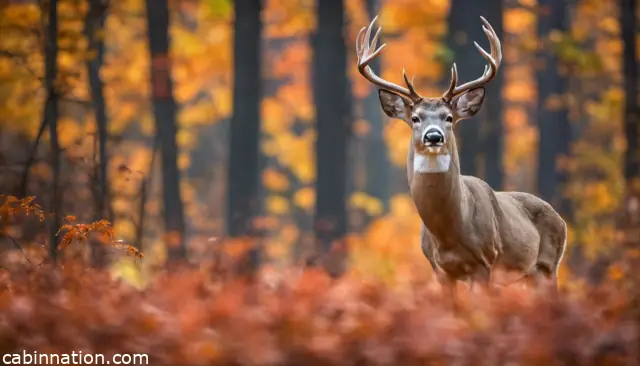
Scrapes in Relation to Rut and Breeding
During the pre-rut season, bucks start marking their territories by creating scrapes. They do so by pawing at the ground, removing vegetation, and depositing their scent onto the exposed soil.
This is usually done around the edges of their home ranges, which also coincide with locations that provide transition security cover and food sources.
Increase in Testosterone
The pre-rut period is when bucks are driven by an increase in testosterone, paving the way for the peak breeding time.
Breeding Season
As the breeding season draws near, bucks begin to check their scrapes more frequently. Mature bucks generally check at least 6-12 scrapes every hour that they are active, especially in the two weeks heading into peak breeding. This increased activity is essential for asserting their dominance and keeping their scent fresh and potent.
Estrus Cycle of Female Deer
During the rut, or rutting season, deer behavior is primarily driven by the estrus cycle of female deer (or does). When does come into estrus, bucks will be more likely to be on the move and visit scrapes, trying to detect any estrus does in the area.
It is important to note that bucks may also visit scrapes of other bucks in their vicinity, as a way to communicate and assert their own dominance.
Use Mock Scrapes to Attract Bucks
One method I’ve found to be effective in attracting bucks is the use of mock scrapes. In this section, I’ll discuss what mock scrapes are and their role in deer hunting.
What are Mock Scrapes
Mock scrapes are man-made imitations of natural deer scrapes. They incorporate a combination of scent and visual cues to entice bucks to visit the area.
Bucks use natural scrapes to communicate with other deer and establish their dominance during the rut. By creating a mock scrape, I can trigger the curiosity and territorial instincts of a buck. If i hunt scrapes or position a trail camera near scrapes, then i increase the chances of an encounter during hunting season.
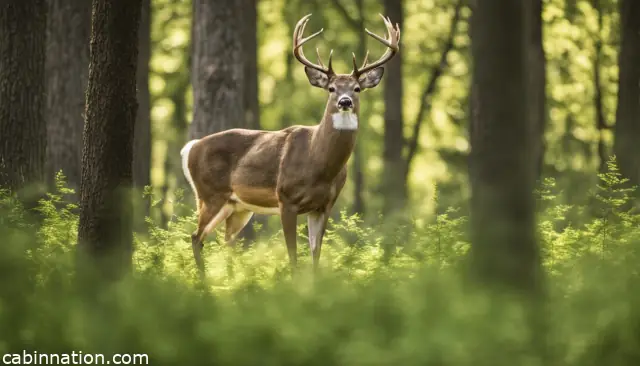
Best Time to Create Mock Scrapes
The most effective time to create mock scrapes is right before the rut, usually in the late summer or early fall.
This time is when bucks are most actively marking their territory and checking for potential mates.
How to Create a Mock Scrape
To create a mock scrape, I first choose a location frequented by deer, typically near a game trail or feeding area. Next, I clear a small circular area of ground, ensuring that the soil is visible, similar to what a natural scrape looks like.
The critical part of a successful mock scrape is the licking branch. This is a small branch or twig positioned above the cleared area that bucks will rub their antlers and glands on to deposit their scent.
Mock Scrape Licking Branch
The licking branch should be sturdy and positioned about 4-5 feet from the ground. To make the mock scrape more enticing, I often use commercial deer scent products or natural deer urine on the branch and the ground.
During daylight hours, and depending on the rut cycle, bucks generally check their scrapes atleast once per day. Persistence and patience are vital since bucks are more likely to reappear during the last few minutes of legal shooting light.
Mock scrapes can be an effective strategy when incorporated into a deer hunter’s arsenal, and I’ve personally had success with this tactic. Remember, deer are highly adaptable animals, so experimenting with different techniques and paying close attention to local deer behavior can significantly improve hunting outcomes.
Use of Scent and Antlers in Scrapes
Bucks use their antlers to rub on the overhanging branches, also known as licking branches, to leave their scent behind.
Lick and Chew on Branches
Not only do they rub their antlers on these branches, but they also lick and chew on them, thus leaving their saliva as another form of scent marker.
Preorbital and Nasal Glands Releasing Scents
The purpose of this behavior is to establish a presence in the area and communicate with other deer, mainly females.
When a buck rubs his forehead, preorbital, and nasal glands on the licking branch or vines, it releases scents that attract doe and let them know that a buck is nearby and available for mating.
While the use of antlers is more exclusive to bucks, I have observed both does and fawns using their own scent glands to mark licking branches and engage in this form of communication as well. It’s fascinating to see how these natural scent markers play such a crucial role in the deer’s social and mating behaviors.
Scrape Lines and Scrape Activity
Scrape lines are a series of scrapes created by bucks. When I’m out hunting, I focus on identifying these lines and monitoring scrape activity to better understand the behavior of the bucks in the area.
Before the peak of the rut, bucks will begin forming scrape lines along their path of travel. Scrapes are marks created on the ground or vegetation where bucks have rubbed their antlers and pawed the ground to leave their scent.
During this time, most scrape activity occurs at night – nearly 85 percent of it, according to the National Deer Association. So, as a hunter, it’s important for me to recognize these patterns to adapt my hunting strategy.
When trying to identify fresh scrapes, I look for clear disturbance in the soil, tree branches, or vegetation. These scrapes are essential since bucks frequently visit them to check on the activity of other deer.
Final Thoughts How Often Do Bucks Check Their Scrapes
Scrapes play a critical role in the social and reproductive behavior of bucks. Hunters should pay close attention to these scrapes. From marking their territories during the pre-rut season to actively communicating with other bucks and does through scents. During the peak breeding and rut periods, scrapes provide a hub of activity in the deer world.
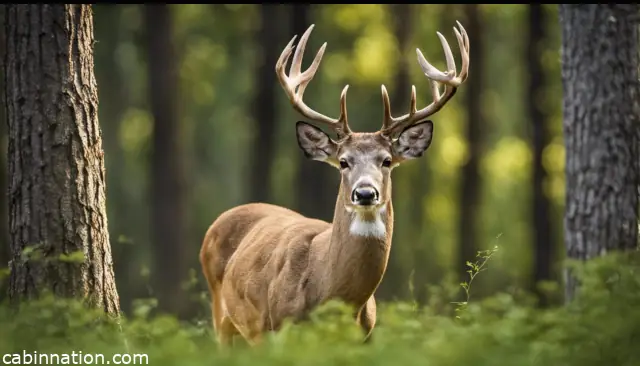
Frequently Asked Questions
What time of day do bucks typically check scrapes?
During the rutting season, bucks will check their scrapes during daylight hours in areas with less hunting pressure. Under intense hunting pressure, mature bucks become nocturnal and mainly visit scrapes during night hours.
Do bucks check scrapes more in the morning, midday, or evening?
Bucks check their scrapes mostly in the evening although they generally do not have a strict pattern when it comes to checking their scrapes. Hunting pressure, availability of food sources, and security cover influence their behavior and may impact the time of day when they visit scrapes.
How long does it take for a buck to find a mock scrape?
It’s essential to place mock scrapes near travel corridors, food sources, and bedding areas to increase the chances of a buck finding and interacting with the mock scrape. There isn’t a specific timeline for a buck to find a mock scrape.
Does the time of day influence how often bucks check scrapes?
Yes, the time of day will influence how often bucks check their scrapes. Mature bucks under intense hunting pressure tend to become nocturnal and may visit scrapes mostly during night hours.
